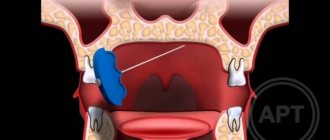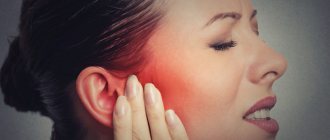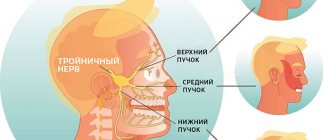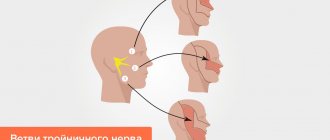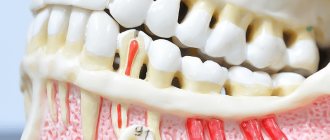Neuritis
is an inflammation of the peripheral nerve trunk.
The peripheral nervous system refers to the nerve structures outside the brain and spinal cord (which are in turn called the central nervous system). Excitation (signal) is transmitted along the nerves, allowing the central nervous system to receive information about the state of all organs and systems of our body and control muscle contractions. The tissues of various organs are penetrated by nerve endings, which are connected to the brain, and in most cases to the spinal cord using bundles of nerve fibers enclosed in a sheath of connective tissue. Such bundles are called nerves, and large nerves are called nerve trunks.
With neuritis, nervous tissue is involved in the inflammatory process. This leads to the fact that the signal in some part of the nerve passes worse or does not pass at all. Accordingly, the sensitivity of any area may be lost and the mobility of the muscles innervated by the affected nerve may decrease.
Types of neuritis
A distinction is made between local neuritis and polyneuritis.
Local neuritis
is an inflammation of any one nerve (facial, auditory, oculomotor, glossopharyngeal, radial, sciatic, peroneal, femoral, etc.).
Polyneuritis
is multiple inflammation of the nerves. If the effect of the factor that caused the inflammation is local, only one nerve is affected. Polyneuritis develops under the influence of a systemic factor, which, as a rule, leads to degeneration of the nerve sheath and nerve fibers.
Classification of neuritis
Depending on the number of affected nerves, it is customary to distinguish two forms of neuritis:
- mononeuritis - one nerve is affected;
- polyneuritis - several nerves are affected.
Depending on which nerve is affected, there are:
- neuritis of the facial nerve;
- trigeminal neuritis;
- acoustic neuritis;
- ulnar nerve neuritis;
- other.
At CELT you can get advice from a specialist algologist.
Make an appointment
Causes of neuritis
Local neuritis is caused by:
- local infection;
- local hypothermia;
- injury. Often neuritis develops after a nerve injury;
- compression of the nerve. Thus, neuritis of the axillary nerve can develop due to prolonged use of a crutch, neuritis of the peroneal nerve - due to working in an uncomfortable position, etc.;
- arthritis (in this case the nerve of the joint may become inflamed);
- tumor (if the tumor compresses the nerve).
Multiple neuritis (polyneuritis) can be caused by such reasons as:
- infectious diseases, including measles, herpes, influenza, malaria, diphtheria and some others;
- intoxication. Poisoning with arsenic, lead, mercury, carbon monoxide, phosphorus, bismuth and other highly toxic substances can lead to the development of various types of neuritis. The most common cause of multiple neuritis is alcohol poisoning;
- systemic diseases (diabetes mellitus, rheumatism, gout);
- avitaminosis;
- vascular disorders;
- as well as some other reasons.
Symptoms
With neuritis, the nerve fiber is damaged, and therefore the functions suffer, the main ones being sensitive, motor and trophic, therefore the following symptoms are clinically noted:
- In the phase of irritation of the nerve fiber: pain, burning, feeling of “crawling goosebumps”, feeling “as if many needles are being pricked”.
- In the phase of loss of functions: decreased muscle strength, muscle atrophy, decreased reflexes, decreased sensitivity, tissue atrophy including skin, subcutaneous fat, muscles, bone tissue.
Symptoms of neuritis
The main symptoms of neuritis are:
Pain along the nerve
The most common symptom of neuritis is pain along the affected nerve. The pain, as a rule, is dull in nature and intensifies in the cold, with physical activity or uncomfortable body position.
Sensory impairment
Sensory loss in the area of the affected nerve is common. It can manifest itself in the form of numbness, tingling, or “pins and needles.”
Decreased muscle activity
There is a partial decrease in muscle strength (paresis), a decrease or loss of tendon reflexes, and in some cases, muscle paralysis (complete cessation of muscle activity).
Vegetative and trophic disorders
With neuritis, there may be such vegetative and trophic disorders as depigmentation of the skin, the acquisition of a bluish tint, local hair loss, increased sweating and dry skin, swelling.
The most common types of neuralgia are:
Intercostal neuralgia
Intercostal neuralgia is compression and pinching (and sometimes irritation) of nerves and nerve ganglia that are located in the intercostal area.
Symptoms of intercostal neuralgia: pain is constant or paroxysmal, and can be shingles.
Pain is usually felt only in one half of the chest (in the intercostal spaces). Sometimes patients complain of impaired sensitivity, tension in the back muscles, pain increases with coughing, deep breathing, body movements and physical activity, as well as with palpation of the sore area. Trigeminal neuralgia
Typical trigeminal neuralgia is characterized by pain on one side of the face, which manifests itself as an attack. The pain is severe in intensity, stabbing in nature, and lasts for several seconds.
As a rule, pain is triggered by something. Thus, it can occur when hypothermia, overheating, chewing, articulation or touching the corresponding part of the face.
The trigeminal nerve is divided into three branches:
- optic branch: responsible for the sensitivity of the forehead and eyelids
- maxillary branch: responsible for the sensitivity of the area from the eyes to the upper lip
- mandibular branch: responsible for the lower lip and the area from the lower jaw to the neck
Neuralgia of the occipital nerve
Neuralgia of the occipital nerve is accompanied by pain in the head area of a shooting nature.
The pain syndrome occurs due to a pinched nerve. As neuralgia progresses, the roots of the cervical spine (from which the occipital nerves are formed) can be affected - the pain becomes constant, and any, even the slightest movements of the head during an attack can be accompanied by nausea, vomiting and sometimes fainting. Pain can also radiate (spread) to the temple, forehead, and eyes. Neuralgia of the external cutaneous nerve of the thigh
The disease develops gradually and is characterized by unilateral damage. Patients complain of a feeling of tingling, numbness, and burning, which first occurs in certain areas of the thigh. Over time they become permanent. The pain appears over several months. Sensitivity along the anterior outer surface of the thigh is impaired. The pain is caused by compression of the fibers of the external cutaneous nerve of the thigh under the inguinal ligament. Some researchers consider such neuralgia to be a manifestation of osteochondrosis.
Treatment methods for neuritis
Neuritis must be treated. At the first signs of the disease, you should consult a neurologist. If treatment for neuritis is not started on time, the risk of developing paresis and muscle paralysis increases.
Treatment of neuritis is aimed, first of all, at eliminating the cause that caused it. If neuritis is of infectious origin, antibacterial therapy or antiviral drugs are used. If neuritis is of toxic origin, it is important to remove toxins from the body.
Drug treatment
In addition to antibacterial or antiviral drugs, the course of treatment for neuritis usually includes:
- B vitamins
- drugs that improve blood microcirculation
- drugs that increase the conductivity of nerve fibers
Massage
Massage of the muscles innervated by the affected nerve is recommended. Massage can be combined with heat therapy (infrared sauna).
More information about the treatment method
Physiotherapy
For neuritis, physical therapy methods such as electrophoresis, diadynamic therapy, SMT therapy, ultrasound therapy, magnetic therapy, and laser therapy can be used.
More information about the treatment method
Make an appointment Do not self-medicate. Contact our specialists who will correctly diagnose and prescribe treatment.
Rate how useful the material was
thank you for rating
Causes of neuralgia
Pinched nerves
For example, with widespread osteochondrosis.
This can cause thoracic and intercostal neuralgia. The neurologist at the Bone Clinic prescribes a treatment program aimed not only at relieving pain and swelling, but also at treating the underlying disease that led to neuralgia (osteochondrosis). Hypothermia, infection or injury
is most often the cause of trigeminal neuralgia
In addition, neuralgia can be a consequence of impaired nutrition (blood supply) of the nerves that occurs due to ischemic disease or atherosclerosis
Causes of neuritis
In order to correctly prescribe treatment for neuritis, it is necessary to correctly identify the causes that caused it. These are bacteria and viruses, as well as:
- intoxication due to poisoning with alcoholic beverages, medications, food;
- nerve compression;
- injury.
The reasons may lie in a number of diseases:
- diabetes;
- rheumatism;
- metabolic disease;
- excess body weight.
Treatment of neuritis of the nerve: ulnar, radial and median
The mobility of the hand is impaired. It is impossible or difficult to bend and straighten it. Moving your fingers hurts. There is a tingling or numbness sensation in the affected area.
Neuropathy occurs with fractures, dislocations of the bones of the shoulder, forearm, hand, or compression in the area of fibrocystic canals. Compression is most often formed as a result of prolonged trauma. In the area of the cubital canal, it is provoked by: systematically repeated flexion movements of the elbow, constant support when working with the elbow on a machine, table, workbench.
In the area of Guyon's canal, compression occurs due to the use of a cane, frequent cycling, motorcycling, or regular work with the same tool: screwdriver, pliers, pliers, jackhammer. Neuralgia can also be caused by:
- tumor;
- enlarged lymph nodes;
- aneurysm of a nearby vessel;
- arthritis or arthrosis of the elbow joint.
When a nerve is damaged, the patient experiences pain, muscle strength decreases, and movement disorders occur. To diagnose, the doctor performs a physical examination, prescribes tests and an MRI.
Treatment for median nerve neuritis, like ulnar neuritis, depends on the cause of the problem. If compression occurs in the area of the cubital canal or Guyon's canal, reduce the compression of the fibers during movement by applying fixing devices: bandages, splints, orthoses. Movements that cause compression should be avoided.
Non-steroidal anti-inflammatory drugs are prescribed to treat ulnar nerve neuritis and reduce symptoms in the form of swelling and pain. Massage and acupuncture have a positive effect on the nervous system. Physiotherapy helps with neuropathy and nerve compression due to fractures and injuries.
However, the disease must be treated after the first signs appear. As soon as one of the symptoms of hand neuritis appears, treatment begins. Otherwise, conservative methods will become ineffective.
Treatment of trigeminal neuralgia at the Yauza Clinical Hospital
Treatment of NTN at the Yauza Clinical Hospital has the primary goal of relieving pain, reducing motor, sensory, and autonomic disorders and preventing recurrent attacks.
For this, specialists from the Neurology Department of the Yauza Clinical Hospital recommend taking anticonvulsants, non-steroidal anti-inflammatory drugs, glucocorticoids, antispasmodics, anticholinesterase drugs, as well as antidepressants and vitamins.
Usually the disease worsens in autumn and winter, so a patient who suffers from neuralgia can plan a visit to a neurologist in advance. Specialists from the Yauza Clinical Hospital will help alleviate the course of NTN and reduce the risk of relapse.
price 526 — Cost of services
You can see more detailed prices for services
Read also
Rehabilitation
Restoration of the body after diseases of the central and peripheral nervous system, operations on the brain and spinal cord, conditions after removal of the mammary gland due to a tumor, consequences...
Read more
Carpal tunnel syndrome
Clinical manifestation of carpal tunnel syndrome This disorder occurs in the median nerve. The causes are tenosynovitis of the flexor tendon in the hands, acute articular rheumatism, pregnancy...
More details
Encopresis
Encopresis is a condition in which a person does not control or feel the urge to defecate, and also cannot control the act of defecation itself; Fecal incontinence significantly impairs the patient’s quality of life,...
More details
Consequences of traumatic injuries to the skull, spine, brain and spinal cord
Traumatic brain injuries, or traumatic brain injuries, are damage to the brain that impair brain function. Brain injuries are divided into two large groups - closed...
More details
Rehabilitation after stroke
It is very important to begin rehabilitation after a stroke as early as possible, since further recovery and the ability to avoid disability depend on this. For rehabilitation after a stroke in the clinic “First...
More details
Neuralgia: symptoms
Clinical manifestations of neuralgia include pain symptoms. It manifests itself in attacks and affects the area of innervation. In addition, the patient may suffer from redness of the skin in the affected area, lacrimation, and convulsive muscle contractions.
| Type of neuralgia | Clinical manifestations |
| Trigeminal neuralgia | The syndrome is characterized by attacks of severe shooting pain along the line of the trigeminal nerve on the left or right. They can be short-term (lasting up to two minutes) or long-term burning pain (lasting up to three days). This symptom most often affects one side of the face. In addition, a spasm or tic of the facial muscles may develop. The pain may involve the eyes, jaws and ears. |
| Intercostal neuralgia | Symptoms of intercostal neuralgia are as follows:
|
| Neuralgia of the submandibular and sublingual nodes | It is characterized by the sudden development of pain symptoms affecting the submandibular area on one side. The anterior two thirds of the tongue hurt; the attack can last from a couple of minutes to one hour. In this case, irradiation to the neck, occipital and temporal regions is possible. Against this background, swelling of the tongue and the area under the lower jaw is possible, and there are disturbances in salivation. |
Diagnosis of neuritis
Specialists at the CELT Pain Clinic pay special attention to differentiating neuritis from:
- multiple sclerosis;
- brain tumors;
- circulatory disorders in the brain.
Facet blockade
- Cost: 10,500 rub.
- Duration: 15-30 minutes
- Hospitalization: 2 hours in hospital
More details
In addition to examination and history taking, electroneuromyography can be used. Thanks to it, you can assess the degree of nerve damage and predict how the disease will progress.
Diagnosis of neuralgia
Our clinic has modern diagnostic equipment that allows us to make a diagnosis as accurately and quickly as possible.
| Type of neuralgia | Diagnostic tests |
| Trigeminal neuralgia | In typical situations it can be easily diagnosed by a neurologist. During the process:
To clarify the diagnosis, you may need:
|
| Intercostal neuralgia | For typical cases, the situation is the same as with trigeminal neuralgia: the diagnosis is made by a neurologist after examination, as well as based on the patient’s complaints. Diagnosis of intercostal neuralgia requires differentiating it from angina pectoris, ischemia, gastric ulcers and pancreatitis. For this, an ECG, fluoroscopy and magnetic resonance imaging of the thoracic spine are prescribed. |
| Neuralgia of the submandibular and sublingual nodes | The diagnosis is made based on the patient's complaints and the results of a neurological examination. Consultation with a dentist may be required. To clarify the diagnosis, a ganglion blockade is performed. |
Diagnosis of trigeminal neuralgia at the Yauza Clinical Hospital
A doctor from the Department of Neurology of the Clinical Hospital on Yauza conducts a differential diagnosis of NTN to exclude other forms of neuralgia, tumors of the cerebellopontine region, abnormalities in the development of blood vessels in the brain stem, migraine and other diseases with similar manifestations.
Research methods include:
- general blood and urine test
- MRI or CT (allows to exclude tumors of the cerebellopontine region)
- examination of ENT organs (radiography of the paranasal sinuses)
- dental examination (panoramic radiography of the oral cavity)
During diagnosis and treatment, it is necessary to consult an otolaryngologist, dentist and psychotherapist.
